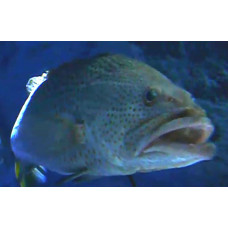Latin name
Anyperodon leucogrammicus
Other names
Whitelined cod, white-lined cod, white-lined rockcod, white-lined rock-cod.
Identification
The head occupies 40% of the total length, the mouth is large and the lower jaw is longer than the upper jaw. It has no palate teeth, which distinguishes it from other sea bass. The mid-lateral scales of the body are ridged, with subsidiary scales.
Features of fish fins
Dorsal fin with 11 spines and 14-16 rays, fin beginning above dorsum, webs clearly separated between spines; anal fin with 3 spines and 8 or 9 rays; soft dorsal and anal fins rounded; pectoral and pelvic fins small, unequal, their length 1.9-2.4 times the length of the body. Pectoral fins thin, transparent and symmetrical; pelvic fins do not reach the anus; caudal fin rounded, with 8 branched rays and 10 outgoing rays in the upper part and 7 branched rays and 9 outgoing rays in the lower part.
Fish colouring
The ground colour is a pale reddish-brown, richly dotted with orange spots, which are more closely spaced on the head. There are five pale silvery-blue vertical lines on each side, the lower three reaching the tail and the upper two splitting into irregular stripes. Juveniles have bright blue and red bars.
Distribution
Widespread in the tropical Indian and Pacific Oceans. The range extends from the east coast of Africa and the Red Sea at 32°E to southern Japan and Australia at 171°W. Can be found in the Andaman Sea.
Habitat
It inhabits coral reefs and seaward reef slopes and lagoons at depths of up to 50 metres (160 feet), sometimes 80 metres (260 feet).
Size
It is a medium-sized fish, reaching a length of about 65 centimetres.
Behavior
Cannibalism is common. Many sea bass can change sex, always from female to male.
Food and feeding habits
Carnivorous, feeding mainly on other fish such as goatfish, but may also eat invertebrates. Juveniles are aggressive imitators of Halichoeres biocellatus and Halichoeres purpurescens. They resemble them in appearance and behaviour, giving potential prey a false sense of security and allowing perch to approach undetected.
Reproduction
Little is known about the reproduction of this species.
Fishing
It is not caught commercially, but can sometimes be seen in Hong Kong fish markets.
| Classification | |
| Phylum | Chordata |
| Class | Actinopterygii |
| Squad | Perciformes |
| Family | Serranidae |
| Genus | Anyperodon |
| Species | A. leucogrammicus |
| Features | |
| Conservation status | Least Concern |
| Habitat | Pelagic |
| Life span, years | No information |
| Maximum body weight, kg | No information |
| Maximum length, cm | 65 |
| Sailing speed, m/s | No information |
| Threat to people | Edible |
| Way of eating | Predator |
Slender grouper
Tags: slender grouper

